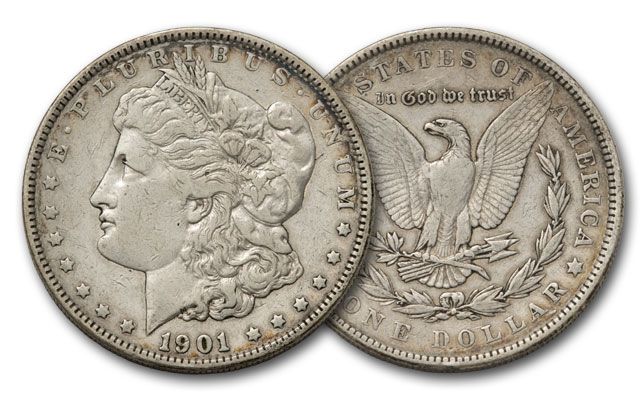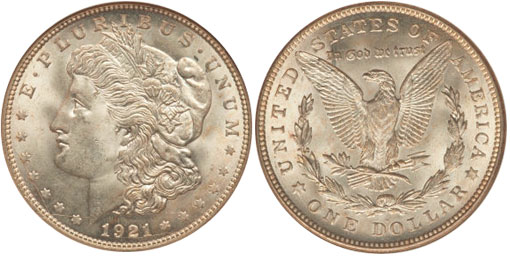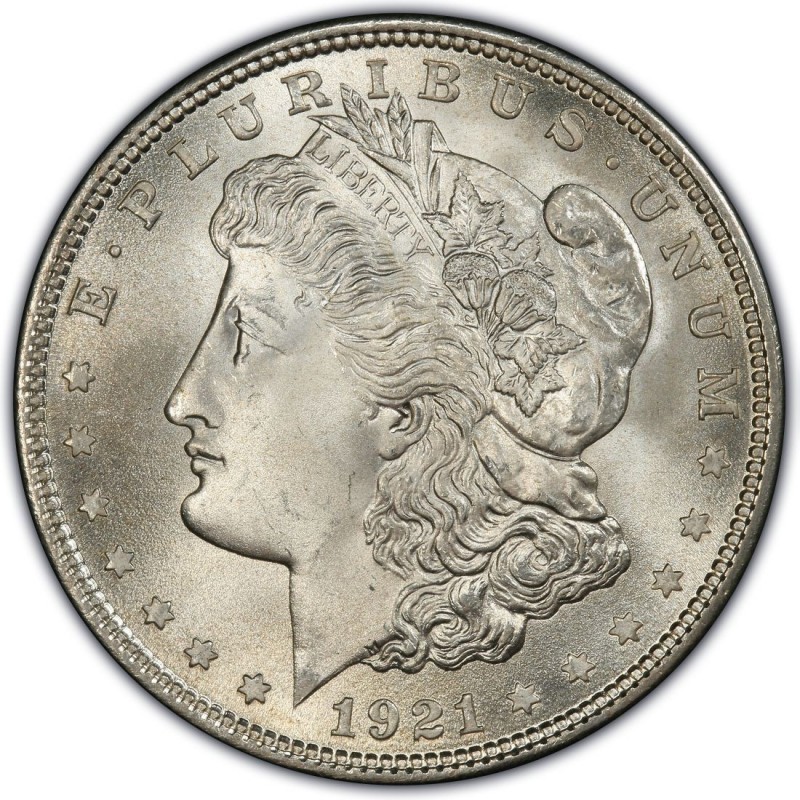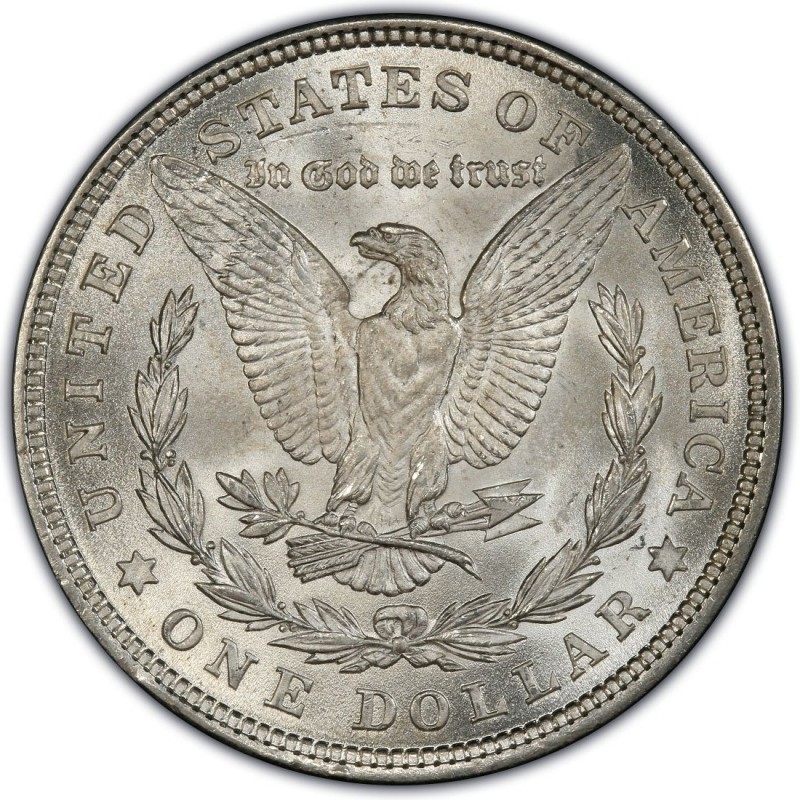1921 Morgan Silver Dollar
Buying 1921 Morgan Silver Dollars. The 1921 Morgan dollar is the most unusual issue in the entire series. After 1904, with national silver bullion supplies all but exhausted, the government suspended coinage of silver dollars altogether. In 1918, under the Pittman Act, more than 270 million silver dollars were melted down for bullion.

USA Coin Book Estimated Value of 1921-S Morgan Silver Dollar is Worth $36 in Average Condition and can be Worth $63 to $1,641 or more in Uncirculated (MS+) Mint Condition. Click here to Learn How to use Coin Price Charts. Also, click here to Learn About Grading Coins. The Morgan Dollars struck in 1921 were made from completely different hubs, and show many design differences on both sides. A complete basic set of Morgan Dollars by date and mint mark consists of 97 coins and represents a major accomplishment to complete in any grade.
If there’s one silver coin that has long captured the imagination of numismatists in the United States, it’s the Morgan Silver Dollar. First introduced in 1878 at a time when silver coining had been on a five-year hiatus, the Morgan design gave the silver dollar coin new prominence in American circulation and enjoys greater popularity today than it did in its day. The Morgan Silver Dollar Coin is available to you online today at Silver.com from the final one-year coining in 1921!
Coin Highlights:
- Ships to you in a protective plastic flip.
- Mintage total for 1921 reached 86,730,000 coins!
- Consists of 26.73 Grams, or .8594 Troy ounces, of actual silver content.
- Issued a face value of $1 (USD) by the United States.
- Obverse features the left-profile portrait of Liberty.
- Reverse includes the American bald eagle.
- Designed by George T. Morgan.
The release of the Morgan Silver Dollar in 1878 was paved with the passage of the Bland-Allison Act. Five years earlier, the United States had ceased to produce silver dollar coins following passage of the Coinage Act of 1873.
At that point in history, the US Mint would actually accept silver from the public to be struck into coinage for a small fee. While the Bland-Allison Act restored the coining of silver dollars, the return of free coining would never happen.
George T. Morgan was a United States Mint Assistant Engraver at the time he developed the silver dollar design. Using Anna Willess Williams as inspiration for his design, Morgan would go on to aid in the creation of other coins and assume the position of Chief Engraver of the United States Mint in 1917 following the death of his boss, Charles E. Barber, who had held the position since 1879.
On the obverse of the Morgan Silver Dollar is the left-profile portrait of Liberty, with 13 stars arranged around her image. The reverse includes the image of the American bald eagle clutching arrows in one talon and an olive branch in the other. This design was replaced later in 1921 by the new Peace Silver Dollars.
The 1921 Morgan Silver Dollar marked the reintroduction of silver dollars after World War I, but it was a short-lived return for the Morgan design. The Philadelphia Mint struck 44.69 million coins that year with no mint mark, while the Denver Mint struck 20.34 million with a “D” mark and the San Francisco Mint struck 21.695 million with an “S” mint mark.
Each of the Morgan Silver Dollar 1921 coins in this product listing are in BU condition. Coins in this condition have no signs of wear and tear, though you may notice a range of minor flaws including breaks in the luster, spotted surfaces, and contact marks from the production process at the mint.
We encourage you to contact Silver.com at 888-989-7223 with questions or connect with us online using our live chat and email features.
Morgan silver dollars range in price from as low as $20 to as high as tens of thousands of dollars. It depends on their condition and the date they were minted, among other factors.
1921 Morgan Silver Dollar
You're probably thinking: That's quite a wide range! This is why you should consult a numismatic expert to appraise the value of your coin when you’re ready to sell.
Each Morgan dollar is struck from 90% silver. Its fine silver weight is 0.77344 troy oz. (Gold and silver are measured in troy ounces.)
Popular Morgan Dollars
If your Morgan dollar is a special variety, it will likely command a higher price. These varieties are commonly known as VAMs. Some of them have earned fascinating nicknames. Most VAMs can only be seen under magnification, but a handful are visible with the naked eye.
Numismatists have even traced the history of each VAM to the dies used to strike the coins.
The abbreviation comes from 'Van Allen Mallis.' These are the last names of the experts who first documented the varieties.
Here are a few of the most popular VAM Morgan silver dollars.
1888-O 'Scarface'
'Scarface' Morgan dollar. Image source: VAMWorld
A die break caused one of the most famous Morgan dollar VAMs called 'Scarface.' A fracture in the die used to strike these coins left a prominent raised line on Lady Liberty's cheek.
1888-O 'Hot Lips'
'Hot Lips' Morgan dollar VAM. Image source: VAMWorld
The 'Hot Lips' VAM is the result of a mint error known as a doubled die. This causes parts of the design to appear doubled or overlapped. In this case, the effect is most obvious on Lady Liberty's lips. The Hot Lips variety is not especially rare but it is highly collectible.

1878-S 'Funky Feather'
1878-S 'Funky Feather' Morgan dollar. Image source: VAMWorld
This variety is from the first year the Morgan dollar was issued. The wing feathers of the eagle on the reverse design are noticeably crude. A portion of the wing exhibits a grainy appearance and is characterized by small raised dots.
Other varieties of the 1878 coin feature different numbers of tail feathers on the eagle.
A noteworthy pedigree will also influence the price of a Morgan silver dollar. In other words, who owned the coin before? Was it part of a famous collection or hoard? Sometimes this is also called the coin's provenance.
The 'PL' designation also adds collectible appeal to any silver coin. This stands for proof-like, meaning the coin has mirrored surfaces. Once unknown, these are now a favorite among collectors.
Below are some general guidelines to help you determine the value of your Morgan dollar.
How To Identify the Branch Mints
Several different branches of the U.S. Mint struck Morgan dollars. This is important to know because certain mints produced less coins in a given year than others.
Each branch corresponds to a mintmark. This is a short abbreviation on the coin that tells you the location where it came from:
- P (Philadelphia Mint)
- D (Denver Mint)
- O (New Orleans Mint)
- S (San Francisco Mint)
- CC (Carson City Mint)
In the case of coins from the Philadelphia Mint, the mintmark is omitted. You won't find a 'P' anywhere on the coin.
So if there is no mintmark, you'll know your coin comes from Philadelphia. As a general rule, these coins had higher mintages. That makes them less expensive than their counterparts from other mints.
How To Find the Mintmark
You will find the mintmark on the reverse of your Morgan near the bottom of the design.
Morgan dollar CC mint mark. Image source: CoinStudy
1923 Peace Silver Dollar Value
Silver dollar coins minted in Carson City, Nevada are prized by collectors. The mint sourced its silver from the legendary Comstock Lode. It was only briefly in operation, however.
Morgan Silver Dollar Price Chart

Here is a list of values for every Morgan dollar minted from 1878 through 1904, as well as 1921.
Keep in mind that these prices are only a general guide. Actual market prices will vary slightly when you sell your coins. Again, it will always depend on the exact condition of the coin. Uncirculated silver Morgan dollar coins garner the highest prices.

1921 Morgan Silver Dollar Value

| Date & Mintmark | Mintage | G | AU | MS |
|---|---|---|---|---|
| 1878 | 10,509,300 | $30 | $60 | $150 |
| 1878-S | 9,774,000 | $30 | $50 | $80 |
| 1878-CC | 2,212,000 | $100 | $180 | $300 |
| 1879 | 14,807,100 | $20 | $50 | $75 |
| 1879-S | 9,110,000 | $20 | $40 | $60 |
| 1879-CC | 756,000 | $180 | $2,000 | $4,000 |
| 1879-O | 2,887,000 | $30 | $50 | $100 |
| 1880 | 12,601,335 | $20 | $40 | $60 |
| 1880-S | 8,900,000 | $20 | $40 | $60 |
| 1880-CC | 495,000 | $180 | $325 | $500 |
| 1880-O | 5,305,000 | $25 | $50 | $100 |
| 1881 | 9,163,975 | $20 | $40 | $60 |
| 1881-S | 12,760,000 | $20 | $40 | $60 |
| 1881-CC | 296,000 | $320 | $450 | $520 |
| 1881-O | 5,708,000 | $30 | $45 | $60 |
| 1882 | 11,101,100 | $20 | $40 | $60 |
| 1882-S | 9,250,000 | $20 | $40 | $60 |
| 1882-CC | 1,133,000 | $80 | $180 | $250 |
| 1882-O | 6,090,000 | $20 | $40 | $60 |
| 1883 | 12,291,039 | $20 | $40 | $60 |
| 1883-S | 6,250,000 | $30 | $120 | $1,000 |
| 1883-CC | 1,204,000 | $60 | $150 | $275 |
| 1883-O | 8,725,000 | $20 | $40 | $60 |
| 1884 | 14,070,875 | $20 | $40 | $55 |
| 1884-S | 3,200,000 | $25 | $250 | $9,000 |
| 1884-CC | 1,136,000 | $100 | $200 | $250 |
| 1884-O | 9,730,000 | $20 | $40 | $60 |
| 1885 | 17,787,767 | $20 | $40 | $60 |
| 1885-S | 1,497,000 | $35 | $110 | $350 |
| 1885-CC | 228,000 | $500 | $620 | $700 |
| 1885-O | 9,185,000 | $20 | $40 | $60 |
| 1886 | 19,963,886 | $20 | $40 | $60 |
| 1886-S | 750,000 | $50 | $150 | $375 |
| 1886-O | 10,710,000 | $30 | $45 | $60 |
| 1887 | 20,290,710 | $20 | $40 | $60 |
| 1887-S | 1,771,000 | $25 | $55 | $160 |
| 1887-O | 11,550,000 | $20 | $50 | $100 |
| 1888 | 19,183,833 | $20 | $40 | $60 |
| 1888-S | 657,000 | $120 | $200 | $350 |
| 1888-O | 12,150,000 | $20 | $40 | $75 |
| 1889 | 21,726,811 | $20 | $40 | $60 |
| 1889-S | 700,000 | $40 | $110 | $290 |
| 1889-CC | 350,000 | $600 | $7,000 | $22,000 |
| 1889-O | 11,875,000 | $25 | $60 | $300 |
| 1890 | 16,802,590 | $20 | $40 | $60 |
| 1890-S | 8,230,373 | $20 | $40 | $100 |
| 1890-CC | 2,309,041 | $75 | $200 | $600 |
| 1890-O | 10,701,000 | $20 | $45 | $100 |
| 1891 | 8,694,206 | $25 | $50 | $100 |
| 1891-S | 5,296,000 | $25 | $50 | $140 |
| 1891-CC | 1,618,000 | $75 | $250 | $650 |
| 1891-O | 7,954,529 | $20 | $60 | $275 |
| 1892 | 1,037,245 | $30 | $100 | $400 |
| 1892-S | 1,200,000 | $50 | $1,400 | $55,000 |
| 1892-CC | 1,352,000 | $200 | $750 | $1,750 |
| 1892-O | 2,744,000 | $25 | $80 | $300 |
| 1893 | 378,792 | $200 | $400 | $1,400 |
| 1893-S | 100,000 | $2,500 | $20,000 | $225,000 |
| 1893-CC | 677,000 | $250 | $2,000 | $5,000 |
| 1893-O | 300,000 | $215 | $800 | $4,000 |
| 1894 | 110,972 | $800 | $1,500 | $3,500 |
| 1894-S | 1,260,000 | $65 | $470 | $1,000 |
| 1894-O | 1,723,000 | $50 | $180 | $1,800 |
| 1895 (proof only) | 880 | n/a | $40,000 | $52,500 |
| 1895-S | 400,000 | $300 | $1,600 | $4,000 |
| 1895-O | 450,000 | $225 | $1,200 | $15,000 |
| 1896 | 9,976,762 | $20 | $40 | $60 |
| 1896-S | 5,000,000 | $40 | $800 | $3,000 |
| 1896-O | 4,900,000 | $30 | $120 | $1,500 |
| 1897 | 2,822,731 | $20 | $40 | $60 |
| 1897-S | 5,825,000 | $20 | $45 | $100 |
| 1897-O | 4,004,000 | $20 | $100 | $1,250 |
| 1898 | 5,884,735 | $20 | $40 | $60 |
| 1898-S | 4,102,000 | $30 | $100 | $390 |
| 1898-O | 4,440,000 | $20 | $40 | $60 |
| 1899 | 330,846 | $125 | $200 | $290 |
| 1899-S | 2,562,000 | $35 | $150 | $500 |
| 1899-O | 12,290,000 | $20 | $40 | $60 |
| 1900 | 8,880,938 | $20 | $40 | $60 |
| 1900-S | 3,540,000 | $30 | $90 | $275 |
| 1900-O | 12,590,000 | $20 | $40 | $60 |
| 1901 | 6,962,813 | $40 | $300 | $3,000 |
| 1901-S | 2,284,000 | $35 | $200 | $500 |
| 1901-O | 13,320,000 | $20 | $40 | $60 |
| 1902 | 7,944,777 | $20 | $45 | $65 |
| 1902-S | 1,530,000 | $100 | $230 | $400 |
| 1902-O | 8,636,000 | $20 | $35 | $50 |
| 1903 | 4,652,755 | $35 | $50 | $65 |
| 1903-S | 1,241,000 | $80 | $1,600 | $4,500 |
| 1903-O | 4,450,000 | $275 | $325 | $400 |
| 1904 | 2,788,650 | $30 | $65 | $140 |
| 1904-S | 2,304,000 | $40 | $50 | $2,000 |
| 1904-O | 3,720,000 | $30 | $40 | $55 |
| 1921 | 44,690,000 | $20 | $30 | $40 |
| 1921-S | 21,695,000 | $20 | $40 | $50 |
| 1921-D | 20,345,000 | $20 | $40 | $50 |
Price guide excludes all proofs and special varieties. Non-proof varieties are accounted for in annual mintage totals.
Prices derived from NGC Coin Explorer, PCGS price guide, and USA CoinBook.
The price chart above is provided for general information purposes. It should not be used or construed as investment advice.
Historical Significance of the Silver Morgan Dollar
Two pieces of legislation in the United States bookend the history of the Morgan dollar. These are the Bland-Allison Act and the Sherman Silver Purchase Act.
The Bland-Allison Act gave birth to the Morgan silver dollar. It marked the first $1 coin issued in the U.S. in five years (aside from the 'Trade dollar').
There was very little demand for dollar coins, however. In 1890, the Sherman Silver Purchase Act attempted to address this problem. The law required the U.S. government to buy $4 million of silver every month from miners in the American West.
The coin is named for its designer, George T. Morgan. His design of Lady Liberty was modeled after Anna Willess Williams. She was a teacher and writer in Philadelphia at the time.
1891 portrait of Anna Willess Williams. Image source: Chalkboard Champions
The 1921 Morgan dollar was the last coin in the series. That year also saw the introduction of the Peace dollar. The theme of 'peace' was a celebration of the end of the First World War.